|
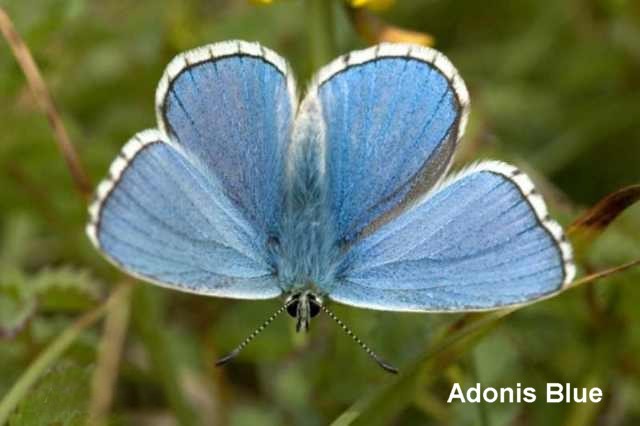 Polyommatus bellargus
Polyommatus bellargus
Distribution:The Adonis blue is a highly restricted species which occurs chiefly in Dorset, Wiltshire and the Isle of Wight, with a few colonies in
Sussex, Surrey, Buckinghamshire and Kent. Over the longer term, the species may spread north in response to climate change.
Habitat:This is a species of chalk downland, preferring sheltered, south-facing slopes. This species is reliant on a closely-cropped turf.
Diet:The sole foodplant is Horseshoe Vetch.
|
|
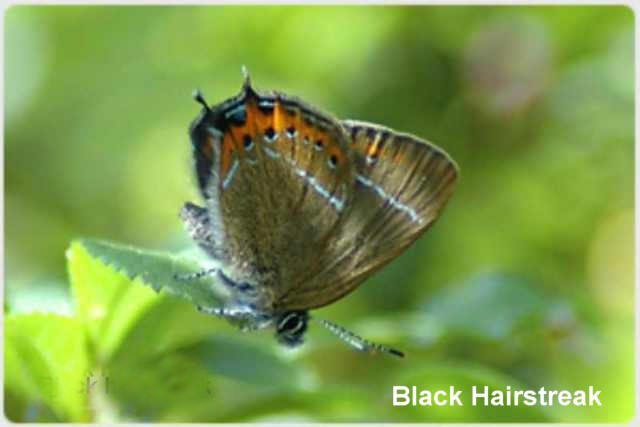 Satyrium pruni
Satyrium pruni
Distribution:Only in English Midlands. The Black Hairstreak declined steadily during the twentieth century in the U.K. and is now reduced to
around 45 sites.
Habitat:Most colonies breed in dense mature stands of Blackthorn growing in sunny, sheltered situations, usually along wood edges or the
edges of rides or glades. Smaller colonies occur in more exposed or shady situations, such as in sheltered hedgerows, small patches of scrub or canopy
gaps in mature woodland.
Diet:Blackthorn is used exclusively by most colonies, but occasionally Wild Plum and other Prunus species are used.
|
|
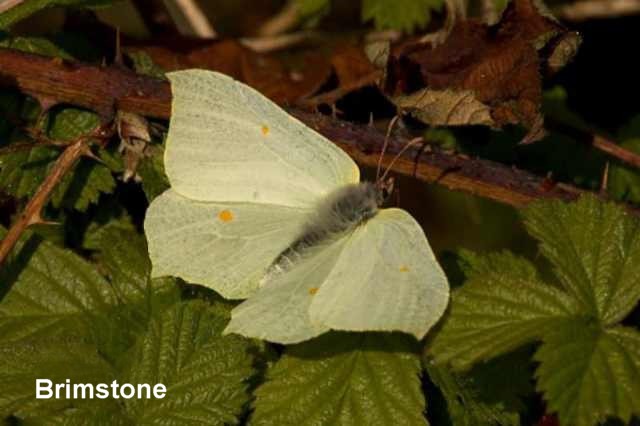 Gonepteryx rhamni
Gonepteryx rhamni
Distribution:Brimstone butterflies are common in most of the UK. They have been spreading in recent years, particularly in northern England. They
are protected in Northern Ireland but they are not listed as endangered.
Habitat:Brimstones are commonest on chalk grassland or deciduous woodland sites, but will breed almost anywhere where the larval
foodplants grow, including heathland, moors, farmland, railway cuttings, and coastal habitats.
Diet:The main foodplants are Alder Buckthorn and Buckthorn.
|
|
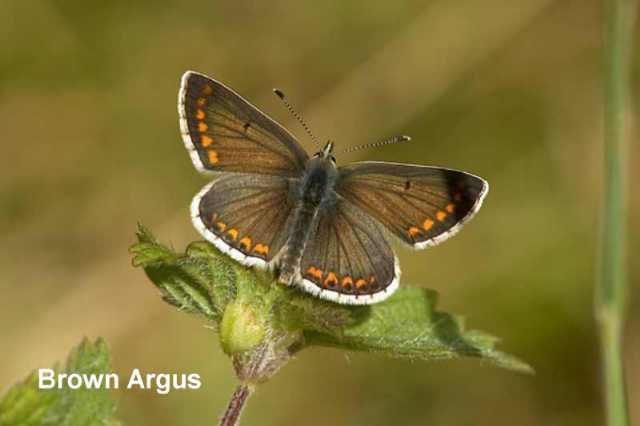 Aricia agestis
Aricia agestis
Distribution:This small butterfly is characteristic of southern chalk and limestone grassland but occurs in a variety of other open habitats as far
north as north Wales and Yorkshire.
Habitat:The butterfly's traditional habitats are chalk and limestone grassland, but it also occurs in a range of other habitats with disturbed soils,
including: coastal grassland and dunes, woodland clearings, heathland, disused railway lines, road verges, and more recently set-aside fields. Sheltered
sites or slopes facing south or west are preferred.
Diet:Common Rock-rose is used almost exclusively on calcareous grassland. In other habitats it uses annual foodplants, mainly Dove's-foot
Crane's-bill and Common Stork's-bill.
|
|
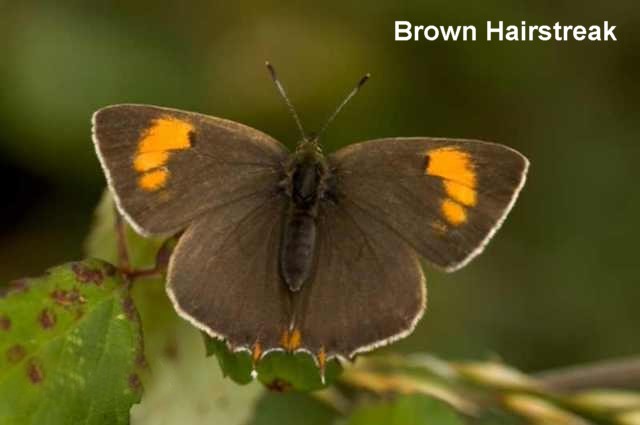 Thecla betulae
Thecla betulae
Distribution:Found in western England and Wales with isolated colonies elsewhere. The butterfly is locally distributed in southern Britain and
mid-west Ireland.
Habitat:Hedges, scrub, and wood edges are used where Blackthorn is abundant and not too intensively managed. The butterfly typically
breeds over wide areas of countryside with extensive networks of hedges and woodland.
Diet:The butterfly breeds on young growth of Blackthorn and occasionally other Prunus species such as Bullace.
|
|
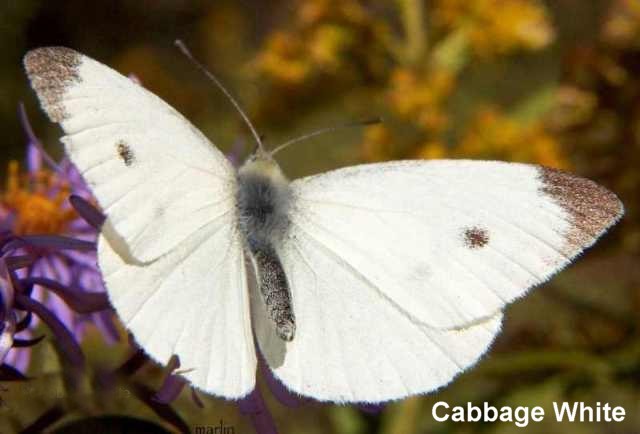 Pieris brassicae
Pieris brassicae
Distribution:To be found all over the United kingdom in a wide range of habitats.
Habitat:This species is found in a wide variety of habitats and can turn up almost anywhere, including gardens, allotments, parks, meadows,
open grassland, and hedgerows.
Diet:The main foodplant is Crucifers crops, eg. cabbage, swede, kale. Nasturtium and Wild Mignonette are also used.
|
|
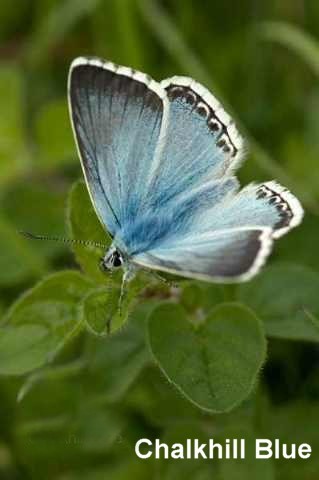 Polyommatus coridon
Polyommatus coridon
Distribution:The butterfly is confined to calcareous grassland in southern England and has declined in some areas during recent decades.
Habitat:Both the foodplant and the butterfly are restricted to chalk and limestone grassland. The Chalkhill Blue breeds on all aspects but
prefers south- and west-facing slopes and shorter turf.
Diet:The sole foodplant is Horseshoe Vetch.
|
|
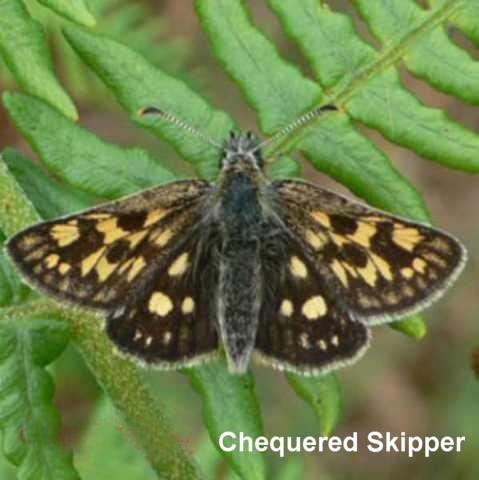 Carterocephalus palaemon
Carterocephalus palaemon
Distribution:A small butterfly with a darting flight that is restricted to central western Scotland.
Habitat:In Scotland the butterfly breeds in open grassland, dominated by tall Purple Moor-grass growing on wet but not waterlogged soils.
Favoured sites are on the edges of open broad-leaved woodland where richer soils produce lusher growth of the foodplant, typically with scattered
Bog-myrtle andbirch scrub. Most breeding areas occur below 200m at the base of a slope, often beside lochs or rivers.
Diet:The main foodplant in Scotland is Purple Moor-grass.
|
|
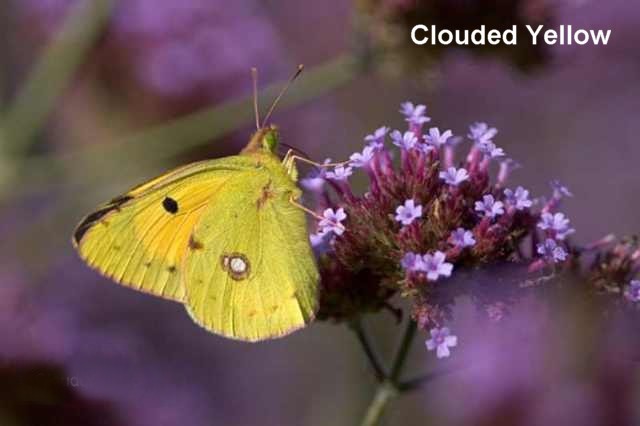 Colias croceus
Colias croceus
Distribution:Occasional, anywhere in Britain. It migrates to the North during Summer.
Habitat:Clouded Yellows may be seen in any habitat, but congregate in flowery places where the larval foodplants grow. As clovers are still
commonly cultivated, the Clouded Yellow is one of the few butterfly species that has no difficulty locating breeding habitat in the modern farmed countryside.
In Southern England there is a preference for unimproved chalk downland.
Diet:A range of leguminous plants is used, including wild and cultivated clovers, Lucerne, and less frequently, Common Bird''s-foot-trefoil.
|
|
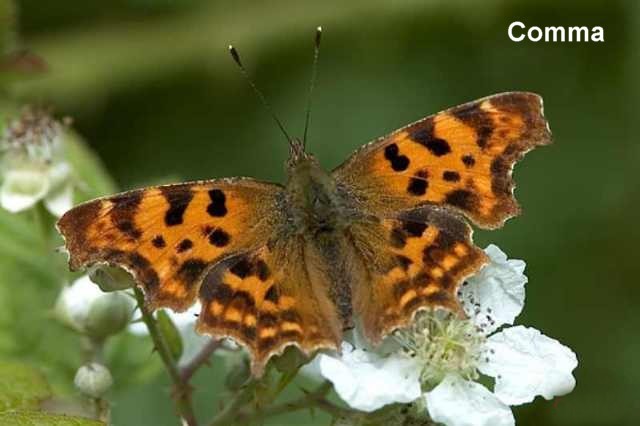 Polygonia c-album
Polygonia c-album
Distribution:The species has a flexible life cycle, which allows it to capitalize on favourable weather conditions. However, the most remarkable
feature of the Comma has been its severe decline in the twentieth century and subsequent comeback. It is now widespread in southern Britain and its range is
expanding northwards.
Habitat:Open woodland and wood edges are the main habitats for both breeding and hibernation. Pre-hibernation individuals range more
widely in search of nectar and rotting fruit, and are seen regularly in gardens and many other habitats.
Diet:The most widely used foodplant is Common Nettle. Other species used include Hop, elms, currants, and willows.
|
|
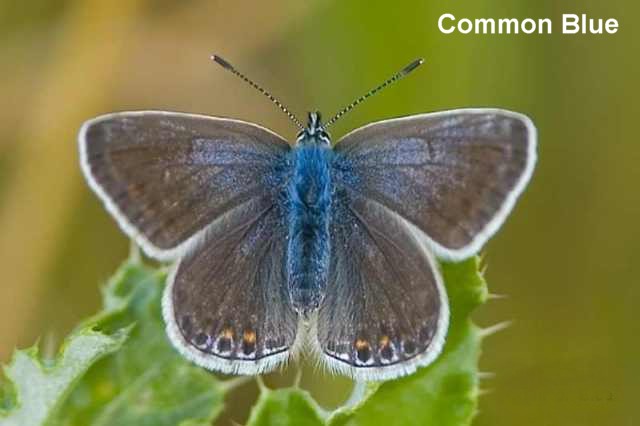 Polyommatus icarus
Polyommatus icarus
Distribution:The common blue is one of the most widespread butterflies in the UK, found throughout the U.K. including Orkney and the Western
Isles
Habitat:It occurs in a range of grassy places where its foodplants grow in sunny, sheltered situations on downland, coastal dunes and
undercliffs, road verges, acid grassland, and woodland clearings. It is also found in waste ground, disused pits and quarries, golf courses, and urban
habitats such as cemeteries
Diet:Common Bird's-foot-trefoil is the main foodplant. Other plants used include: Greater Bird's-foot-trefoil, Black Medick, Common Restharrow, White Clover, and Lesser Trefoil.
|
|
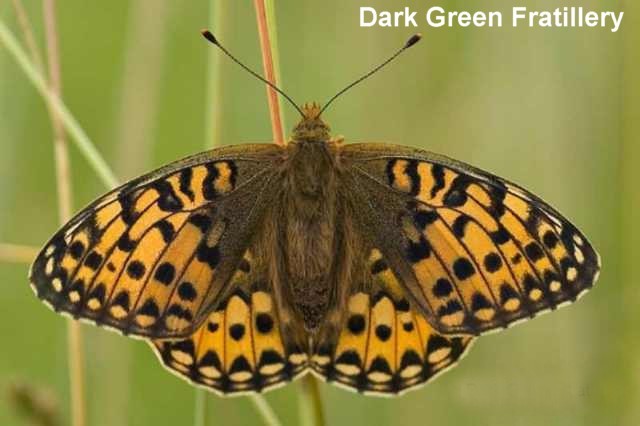 Argynnis aglaja
Argynnis aglaja
Distribution:Although the Dark Green Fritillary is still locally abundant in some regions, it has declined in many others, notably central and
eastern England.
Habitat:The butterfly occurs in a range of flower-rich grasslands, often with patches of scrub, including: coastal grassland, dunes and scrub;
chalk and limestone grassland; moorland and wet flushes; acid grassland with bracken; and occasionally woodland rides and clearings.
Diet:Common Dog-violet is used in many habitats but Hairy Violet is used on calcareous grasslands, and Marsh Violet on moorland and
wetter habitats in the north and west. Other violets may be used occasionally.
|
|
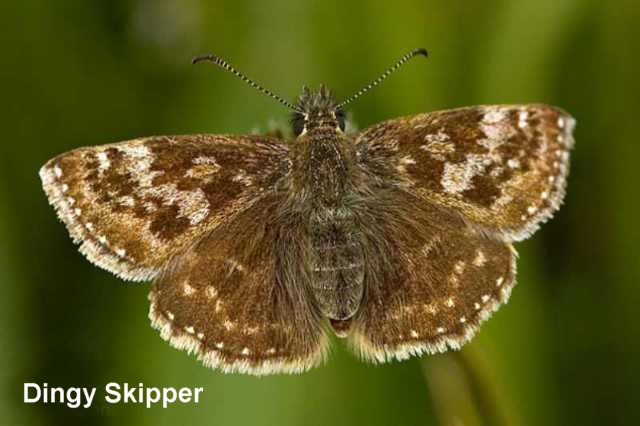 Erynnis tages
Erynnis tages
Distribution:Common in England and Wales. Scarce in Scotland and Ireland.
Habitat:Colonies occur in a wide range of open, sunny habitats including chalk downland, woodland rides and clearings, coastal habitats
such as dunes and undercliffs, heathland, old quarries, railway lines, and waste ground.
Diet:Common Bird's-foot-trefoil is the usual foodplant in all habitats. Horseshoe Vetch is also used on calcareous soils, and Greater
Bird's-foot-trefoil is used on heavier soils.
|
|
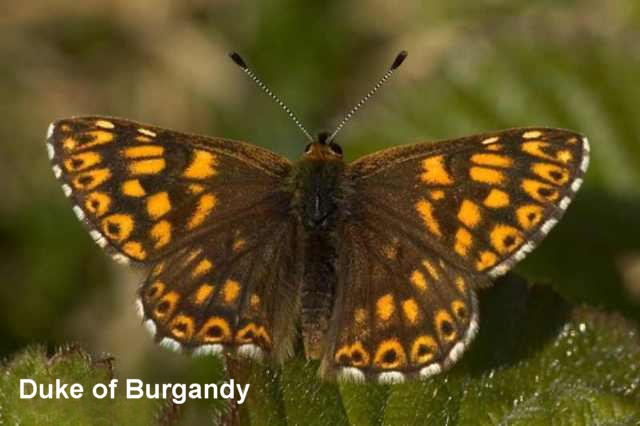 Hamearis lucina
Hamearis lucina
Distribution:The Duke of Burgundy is found in scattered colonies across southern England, with more isolated colonies in the southern Lake District
and North Yorkshire. It has declined substantially in recent decades, especially in woodlands where it is reduced to fewer than 20 sites.
Habitat:Two principal habitats are used: chalk or limestone grassland, with either extensive areas of scrub or topographical shelter; or
clearings on ancient woodland sites, either regenerating coppice, young plantations, sizeable glades or wide rides.
Diet:The main foodplants are Cowslip and Primrose. It occasionally uses the so-called 'False Oxlip', the hybrid of these two Primula species.
|
|
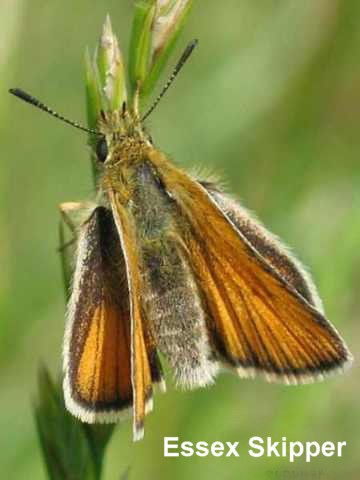 Thymelicus lineola
Thymelicus lineola
Distribution:Essex and along the Thames Estuary towards the London Suburbs. Colonies also exist in the Cotswolds alongside newly constructed
bypasses
Habitat:The Essex Skipper is found in tall, dry grasslands in open sunny situations, especially roadside verges, woodland rides and acid
grasslands, as well as coastal marshes.
Diet:The main species used is Cock's-foot, although the butterfly may use several other grasses including Creeping Soft-grass, Common Couch,
Timothy, Meadow Foxtail, False Brome, and Tor-grass.
|
|
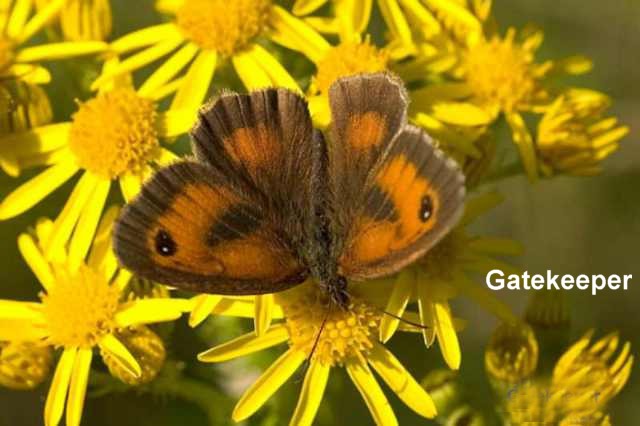 Pyronia tithonus
Pyronia tithonus
Distribution:The Gatekeeper is typically found throughout much of England and Wales, especially within the southern counties. It is widespread in
southern Britain and its range has extended northwards in recent years. Its range is far more localized in southern Ireland.
Habitat:Known to favour shrubs as their main habitat, the Gatekeeper can also typically be seen in scrub, woods and glades.
Diet:Various grasses are used, with a preference for fine grasses such as bents, fescues, and meadow-grasses. Common Couch is also used.
|
|
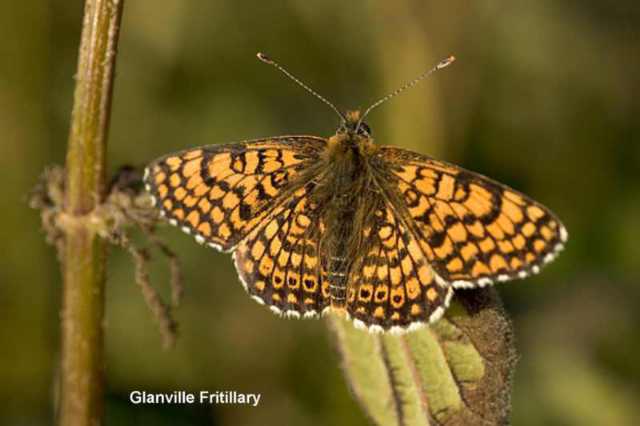 Melitaea cinxia
Melitaea cinxia
Distribution:Southern half of the Isle of Wight and also on the Channel Islands.
Habitat:Two habitat types are used: coastal grasslands either on undercliffs where there is soil slippage, deeply incised coastal river valleys
with eroding sides, or cliff tops; and south facing chalk downland.
Diet:The main foodplant is Ribwort Plantain. Buck's-horn Plantain is used occasionally as a secondary foodplant.
|
|
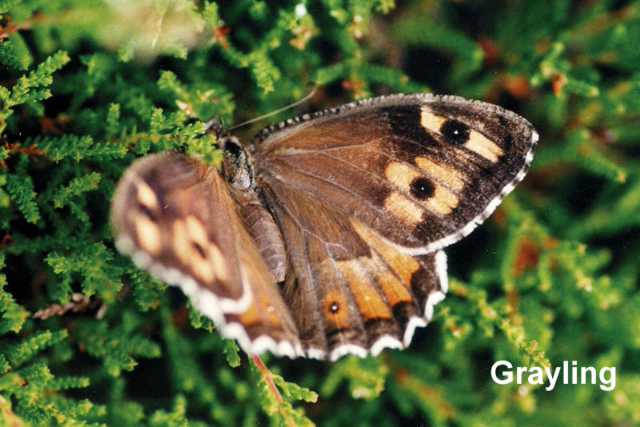 Hipparchia semele
Hipparchia semele
Distribution: The Grayling is widespread on the coast and southern heaths, but is declining in many areas, particularly inland.
Habitat: Many colonies are coastal, on dunes,
saltmarsh, undercliffs, and clifftops. Inland, colonies are found on dry heathland, calcareous grassland, old quarries, earthworks, derelict industrial sites
such as old spoil heaps and, in a few areas, in open woodland on stony ground. It occurs on a wide range of soil types, but all are dry and well-drained,
with sparse vegetation and plenty of bare ground in open positions.
Diet:The main species used include Sheep's, Red Fescue, Bristle Bent, and Early Hair-grass. Coarser grasses such as Tufted Hair-grass and Marram are
occasionally used.
|
|
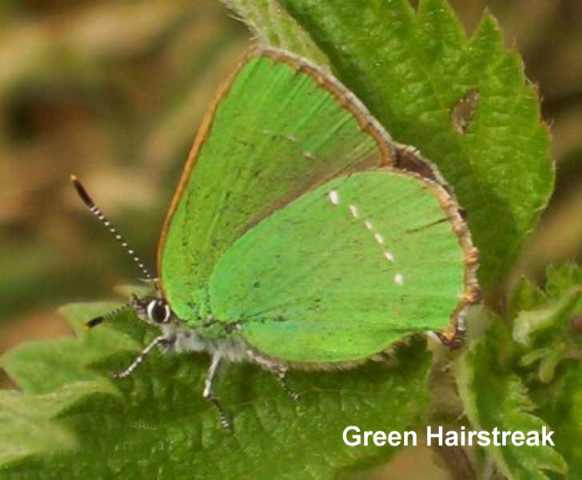 Callophrys rubi
Callophrys rubi
Distribution: Although the Green hairstreak is a widespread species, it often occurs in small colonies and has undergone local losses in several regions.
Habitat: Green Hairstreak colonies may be found on calcareous grassland, woodland rides and clearings, heathland, moorland, bogs, railway cuttings,
old quarries, and rough, scrubby grassland. This species occurs on a wide range of soils but is strongly associated with scrub and shrubs, which are usually
present at sites where it breeds.
Diet: Common Rock-rose and Common Bird's-foot-trefoil are used on calcareous grassland, while Gorse, Broom, and Dyer''s Greenweed are used on
heathland and other habitats. Bilberry is used almost exclusively on moorland and throughout Scotland.
|
|
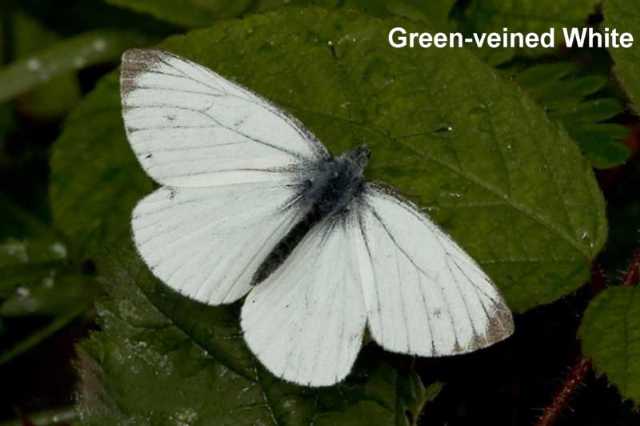 Pieris napi
Pieris napi
Distribution: This butterfly is common and widespread in Britain and Ireland, but it is probably less abundant than formerly due to loss of its grassland habitats.
Habitat: Adults occur widely but tend to congregate in damp, lush vegetation where their foodplants are found, especially hedgerows, ditches, banks of
rivers, lakes, and ponds, damp meadows and moorland, and woodland rides and edges.
Diet: A range of wild crucifers is used: Garlic Mustard, Cuckooflower, Hedge Mustard, Water-cress, Charlock, Large Bitter-cress, Wild Cabbage, and
Wild Radish. Nasturtium and cultivated crucifers are also used occasionally.
|
|
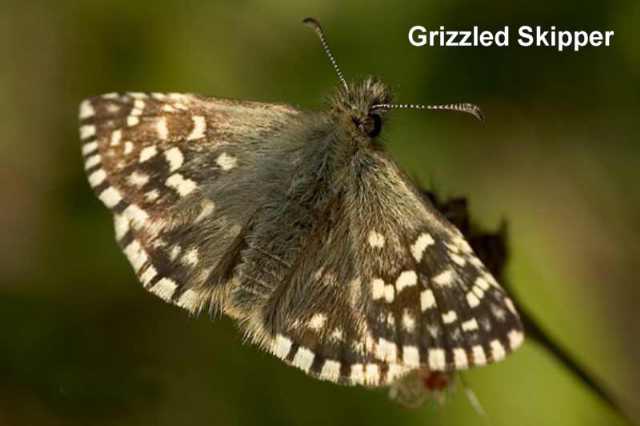 Pyrgus malvae
Pyrgus malvae
Distribution: The Grizzled Skipper is a characteristic spring butterfly of southern chalk downland and other sparsely vegetated habitats. This butterfly occurs
across southern England, commonly in small colonies, and has declined in several regions, especially away from the chalk.
Habitat: Three main types are used: woodland rides, glades, and clearings; unimproved grassland, especially chalk downland but also on other
calcareous soils including clays; and recently abandoned industrial sites such as disused mineral workings, spoil heaps, railway lines, and even rubbish
tips. Occasionally, it breeds on heathland, damp grassland, and dunes.
Diet: A variety of plants from the Rosaceae family is used, mainly Agrimony, Creeping Cinquefoil and Wild Strawberry. It may also use Barren
Strawberry, Tormentil, Salad Burnet, Bramble, Dog-rose, and Wood Avens
|
|
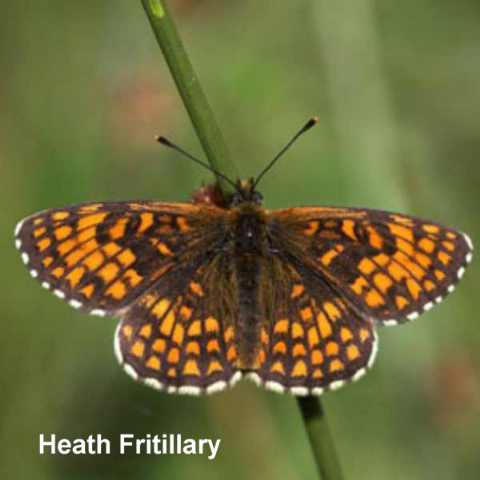 Melitaea athalia
Melitaea athalia
Distribution: The Heath Fritillary is restricted to woodland clearings at a few sites in Cornwall, Devon, Essex and Kent, and to sheltered valleys on Exmoor.
Habitat: The species uses sunny, warm, and sheltered habitats of two main types: coppiced or newly felled woodland on acid soils where Common Cow
-wheat is abundant; and sheltered heathland valleys on Exmoor up to 200-400m above sea level, where Common Cow-wheat grows as scattered plants.
Diet: The main foodplants are Common Cow-wheat, Ribwort Plantain, Germander Speedwell, and occasionally other speedwells. Foxglove can be a
secondary foodplant, especially on Exmoor.
|
|
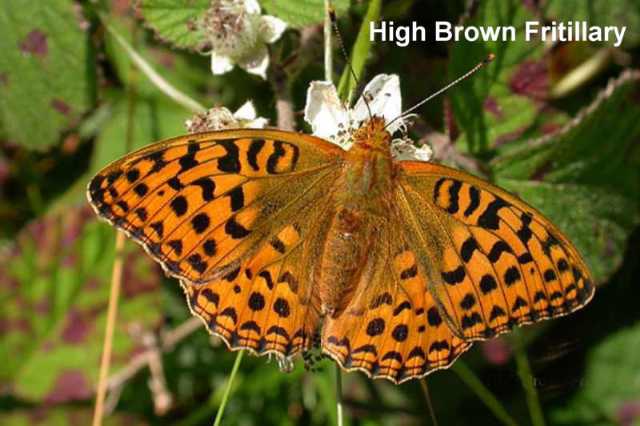 Argynnis adippe
Argynnis adippe
Distribution: The High Brown Fritillary found on Dartmoor and Morecambe Bay, and in a few locations in western England and in Wales.
Habitat: Two main habitats are used: bracken-dominated habitats or grass/bracken mosaics, and limestone rock outcrops, usually where scrub or
woodland has recently been cleared or coppiced. Formerly the butterfly occurred in woodland clearings, probably where bracken was also present.
Diet: Common Dog-violet is used in all habitats, but Hairy Violet is also used in limestone areas. It may occasionally use Heath Dog-violet and Pale
Dog-violet.
|
|
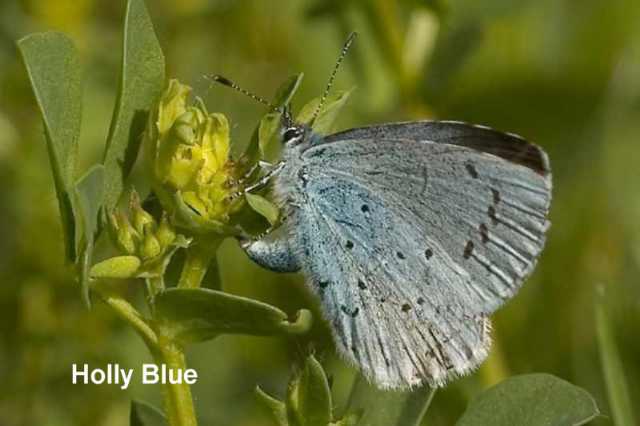 Celastrina argiolus
Celastrina argiolus
Distribution: The Holly blues are widespread throughout Britain and Europe.
Habitat: They inhabit woodlands and gardens, particularly where there is both holly and ivy.
Diet: The spring brood of caterpillars feed on holly, whereas the summer brood feed on ivy. Caterpillars also feed on gorse and bramble. Adults tend
to feed on the flowers of ivy and holly.
|
|
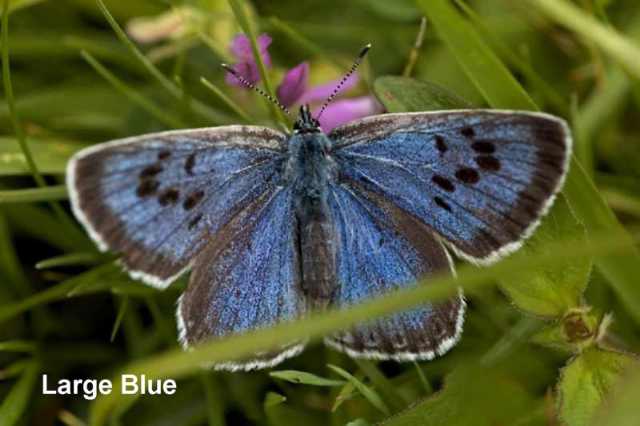 Maculinea arion
Maculinea arion
Distribution: The Large Blue butterfly became extinct in the United Kingdom in 1979, but has since been reintroduced by conservationists.
Habitat: Can be found on the Polden Hills in Somerset and in areas of Datrmore. The Large Blue primarily resides in heaths, sand dunes and hillsides.
Diet: Large Blue caterpillars feed on wild Thyme or Marjoram flowers for the first few days of development. Afterwards, they seek out the nests
of Myrmica sabuleti, a specific species of red ant, and hibernate inside their tunnels. On emerging from hibernation, the caterpillars will then begin to eat
the red ant's eggs and larvae for up to 3 weeks. It will then hang itself by its legs on the nest's roof and build a chrysalis around itself. The caterpillar will
spend a further 3 weeks transforming into the Large Blue butterfly adult. After its change from caterpillar to butterfly, the insect emerges from its chrysalis
and leaves the red ant nest to find a mate. Usually, red ants will escort the newly emerged butterfly to the surface, taking it to a low plant or shrub nearby.
The red ants will encircle the butterfly and ward off any predators that attempt to attack the butterfly as it dries out.
|
|
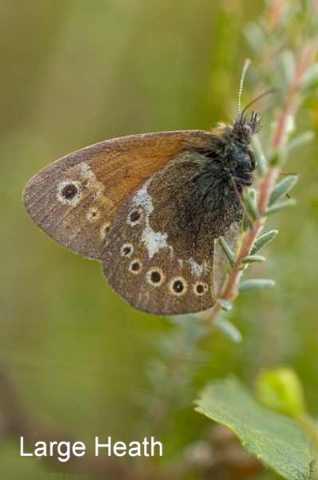 Coenonympha tullia
Coenonympha tullia
Distribution: The butterfly has declined seriously in England and Wales, but is still widespread in parts of Ireland and Scotland.
Habitat: The butterflies breed in open, wet areas where the foodplant grows: lowland raised bogs, upland blanket bogs; and damp acidic moorland.
Sites are usually below around 500m (600m in the far north) and have a base of Sphagnum moss, interspersed with dense tussocks of Hare's-tail Cottongrass
and abundant Cross-leaved Heath, the main adult nectar source.
Diet: The main foodplant is Hare's-tail Cottongrass but larvae have been found occasionally on Common Cottongrass and Jointed Rush
|
|
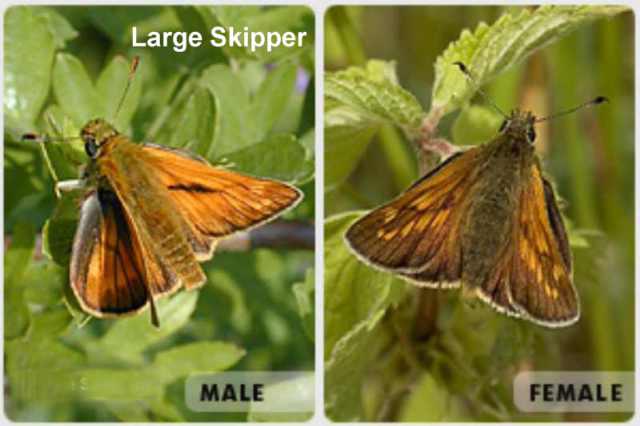 Ochlodes sylvanus
Ochlodes sylvanus
Distribution: The Large Skipper is widespread in southern Britain and its range has extended northwards in north-east England since the 1960s.
Habitat: This butterfly favours grassy areas, where foodplants grow in sheltered, often damp, situations and remain tall and uncut. It is found in a wide
variety of habitats where there are shrubs, tall herbs, and grasses, for example woodland rides and clearings, pastures, roadside verges, hedgerows, and
wet heathland.
Diet: Cock's-foot and occasionally Purple Moor-grass and False Brome are used.
|
|
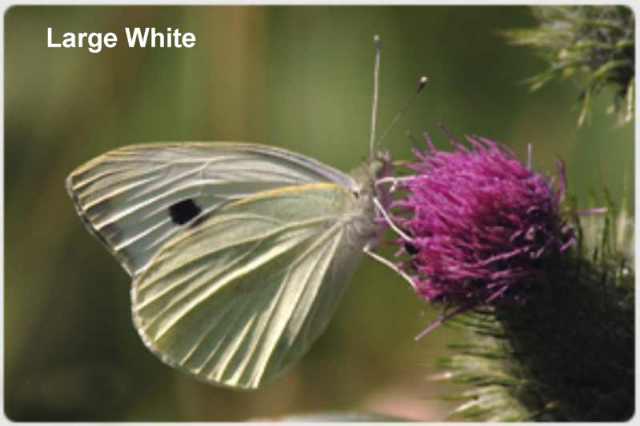 Pieris brassicae
Pieris brassicae
Distribution: This species is widespread in the British Isles.
Habitat: This species is found in a wide variety of habitats and can turn up almost anywhere, including gardens, allotments, parks, meadows, open
grassland, and hedgerows.
Diet: The main foodplant is Crucifers. Nasturtium and Wild Mignonette are also used.
|
|
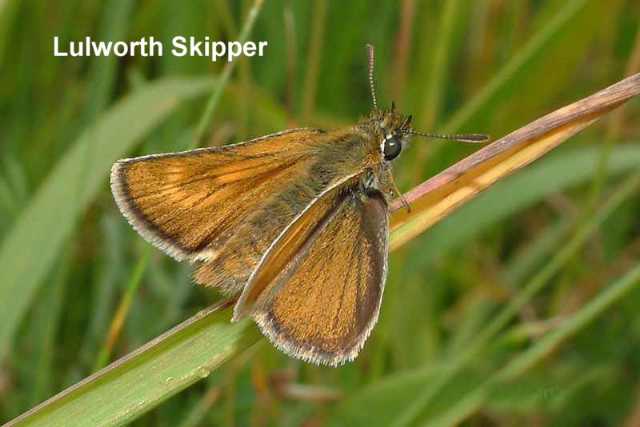 Thymelicus acteon
Thymelicus acteon
Distribution: Mostly Dorset, but also Devon and Cornwall.
Habitat: The main habitats are unfertilized calcareous grasslands, including chalk downland, coastal grassland, and undercliffs.
Diet: The butterfly breeds on tall patches of Tor-grass.
|
|
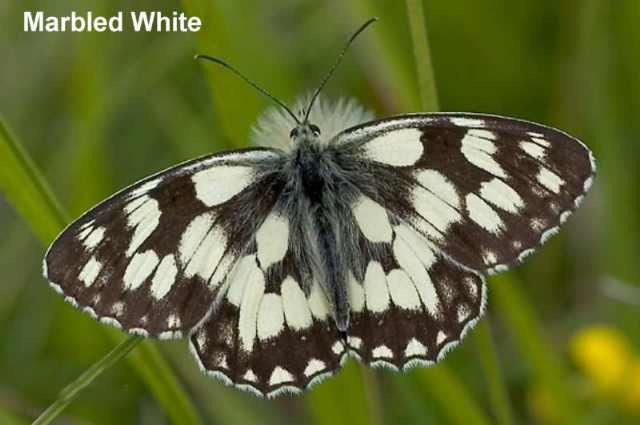 Melanargia galathea
Melanargia galathea
Distribution: This species is widespread in southern Britain and has expanded northwards and eastwards over the last twenty years, despite some losses
within its range.
Habitat:: Colonies occur on unimproved grassland where a range of grass species, including Red Fescue, form a tall sward that is cut or grazed
infrequently. The strongest populations are found on chalk or limestone, but a range of habitats is used, including woodland rides and clearings, coastal
grassland, waste ground, set-aside, road verges, and railway embankments..
Diet: Red Fescue is thought to be essential in the diet of larvae but Sheep's-fescue, Yorkshire-fog, and Tor-grass, are also eaten. It is thought that
several other grasses may be used, but the full range is not known. .
|
|
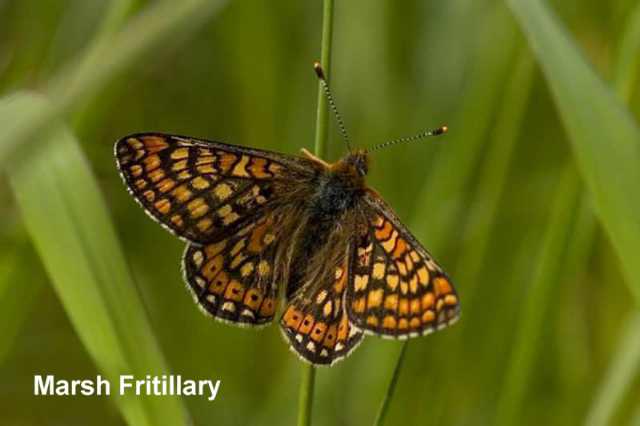 Euphydryas aurinia
Euphydryas aurinia
Distribution: In Britain its range has declined by over 60% and it has recently died out over much of eastern England and Scotland. Although it is still
quite widespread in parts of western England, Wales and western Scotland, colonies are estimated to be disappearing at a rate of well over 10% per
decade.
Habitat: Damp or heathy grassland dominated by tussock-forming grasses; Calcareous grassland (usually on west or south-facing slopes in England).
Diet: Devil's-bit Scabious. On calcareous grassland, it occasionally uses Field Scabious and Small Scabious.
|
|
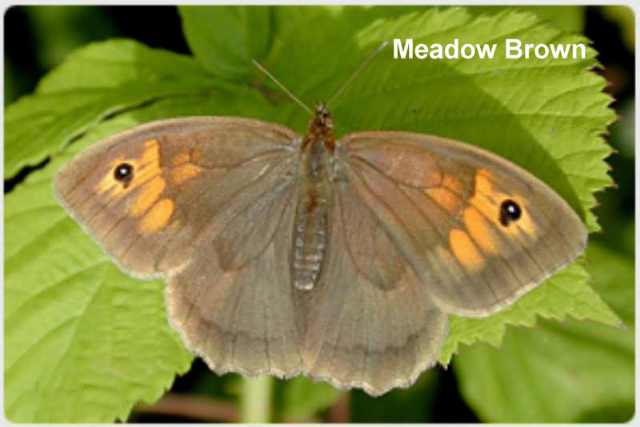 Maniola jurtina
Maniola jurtina
Distribution: Absent from the Shetlands, the Meadow Brown is common in most parts of the British Isles with the exception of higher ground levels.
Habitat: Lush, grassy and sheltered spots are the areas where this butterfly may be spotted, including verges and hedgerows, cliffs and woodland
glades. It rarely ventures into cultivated gardens, preferring to remain close to its breeding sites.
Diet:A wide range of grasses is used. Those with finer leaves such as fescues, bents, and meadow-grasses are preferred, but some coarser species
such as Cock's-foot, Downy Oat-grass, and False Brome are also eaten.
|
|
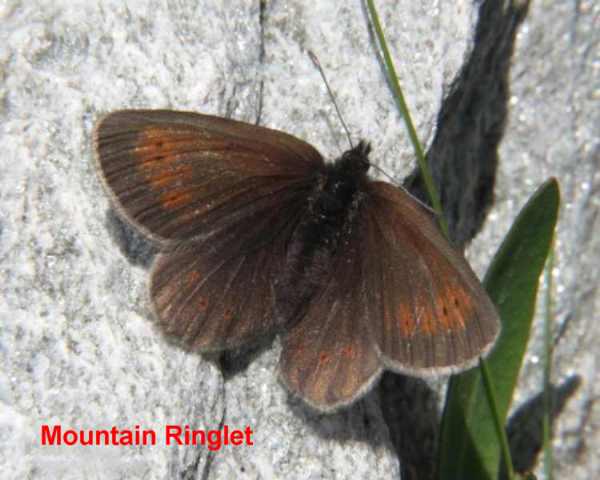 Erebia epiphron
Erebia epiphron
Distribution: The Mountain ringlet is rare in the UK and is restricted to the Lake District and Scottish Highlands.
Habitat: They can be seen in meadows in mountainous areas on sunny days.
Diet: Mat grass.
|
|
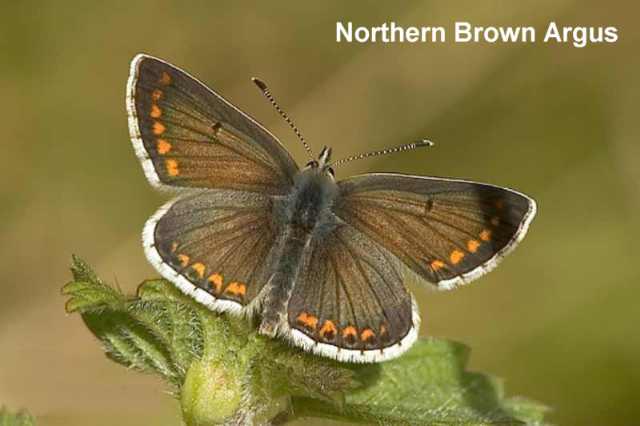 Plebeius artaxerxes
Plebeius artaxerxes
Distribution: The range is restricted to Northern England and Scotland
Habitat: The butterfly occurs in well drained, unimproved grasslands where Common Rock-rose grows in a lightly grazed or ungrazed sward. Most
sites are sheltered (often with scrub) and have thin, base-rich soils with patches of bare ground, for example coastal valleys, steep slopes, sand dunes, and
quarries.
Diet: Common Rock-rose
|
|
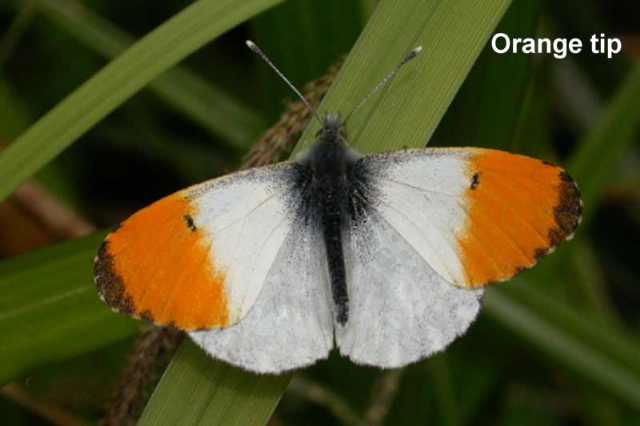 Anthocharis cardamines
Anthocharis cardamines
Distribution: Can be found all over the UK.
Habitat: Damp pastures and meadows, damp woodland edges and glades, riverbanks, ditches, dykes, fens, railway cuttings and country lanes.
Diet: Cuckooflower in damp meadows and Garlic Mustard along road verges and ditches. Occasionally, it uses Hedge Mustard andWinter-cress.
|
|
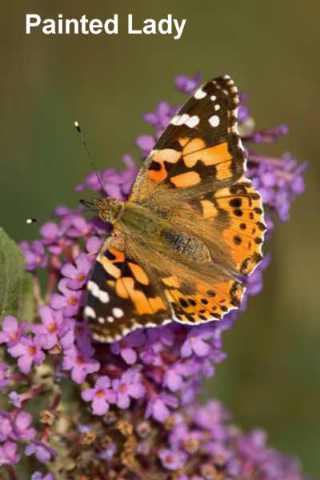 Cynthia cardui
Cynthia cardui
Distribution: The Painted Lady is a long-distance migrant, which causes the most spectacular butterfly migrations observed in Britain and Ireland. Each year,
it spreads northwards from the desert fringes of North Africa, the Middle East, and central Asia, recolonizing mainland Europe and reaching Britain and
Ireland. In some years it is an abundant butterfly, frequenting gardens and other flowery places in late summer.
Habitat: Because it is a wide-ranging migrant, the Painted Lady may be seen in any habitat. Adults tend to congregate in open areas with plenty of
thistles, which serve both as larval foodplants and nectar sources for adults.
Diet: A wide range of foodplants may be used, with thistles being preferred in Britain and Ireland. Mallows, Common Nettle, Viper's-bugloss.
|
|
 Inachis io
Inachis io
Distribution: The Peacock Butterfly is widespread and has continued to expand its range in northern parts of Britain and Ireland.
Habitat: Peacock butterflies may be seen almost anywhere, searching for suitable breeding or nectaring sites. These are often open, sunny places in
woodland where the preferred nectar plants are found, e.g. willows in spring and teasels, thistles, and Hemp-agrimony in late summer. Large nettle patches
are normally chosen for egg laying and these too are often located in sunny positions in the shelter of woodland or hedgerows.
Diet: Common Nettle, although eggs and larvae are occasionally reported on Small Nettle and Hop
|
|
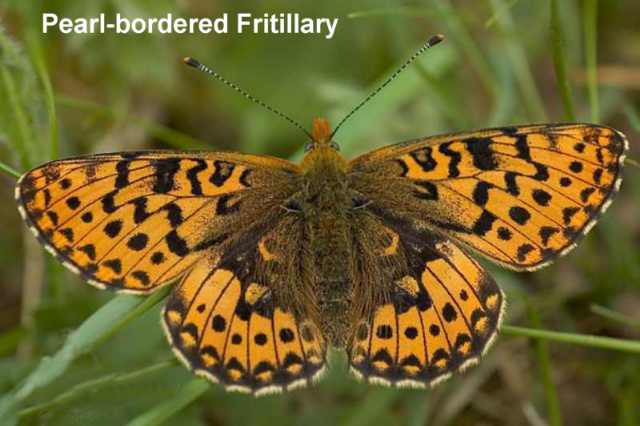 Boloria euphrosyne
Boloria euphrosyne
Distribution: This butterfly was once very widespread but has undergone a rapid decline of over two-thirds in the last two decades.
Habitat: Pearl-bordered fritillaries live in woodland clearings where trees have recently been cut down or coppiced, and where there are areas of
grass, bracken and open scrub.
Diet: Both caterpillars and adult butterflies feed on common dog-violet and sometimes heath dog violet and marsh violet.
|
|
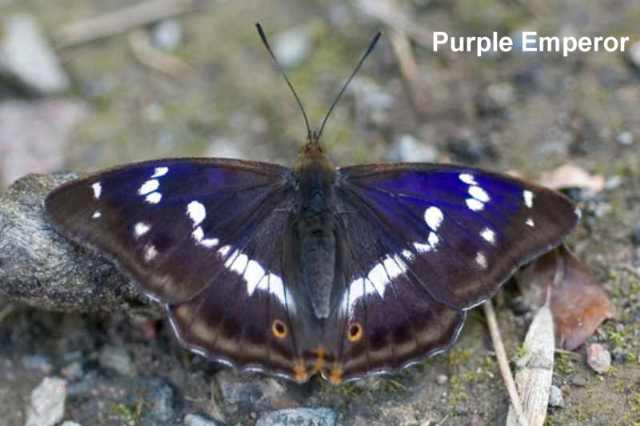 Apatura iris
Apatura iris
Distribution: Restricted to large woods in southern England where they spend much of their time in the treetops.
Habitat: The butterfly requires large blocks of broad-leaved woodland or clusters of smaller woods and/or dense scrub where the foodplants are
abundant.
Diet: Goat Willow is the most widely used foodplant although it also breeds on Grey Willow and more rarely, Crack-willow.
|
|
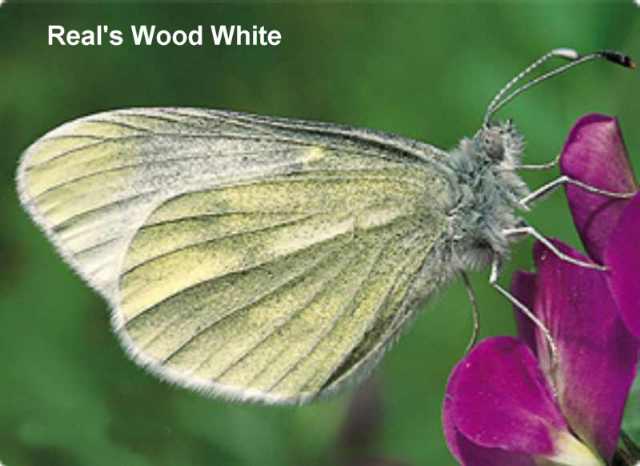 Leptidea reali
Leptidea reali
Distribution: Only found in Ireland where it is widespread.
Habitat: Real's Wood White breeds in open habitats including rough grassland, hedgerows, road verges,disused railwaylines, and areas of light scrub .
Diet: Meadow Vetchling, Tufted Vetch, Common Bird's-foot-trefoil, and Greater Bird's-foot-trefoil.
|
|
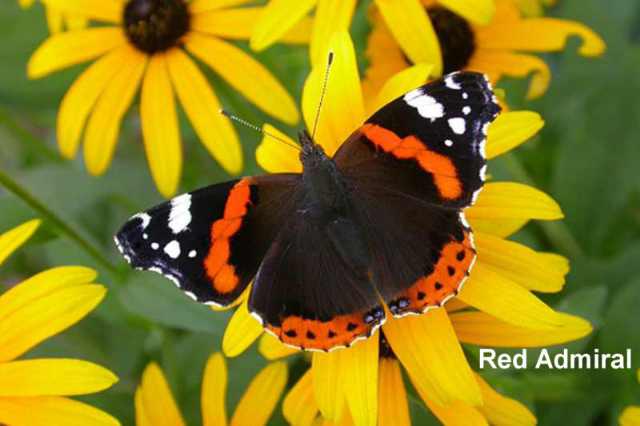 Vanessa atalanta
Vanessa atalanta
Distribution: This familiar and distinctive insect may be found anywhere in Britain and Ireland and in all habitat types.
Habitat: This strong-flying migratory species may be seen throughout Britain and Ireland and in almost any habitat, from sea-shore to town centres
and the tops of mountains.
Diet: Common Nettle. However Small Nettle and the related species, Pellitory-of-the-wall and Hop may also be used.
|
|
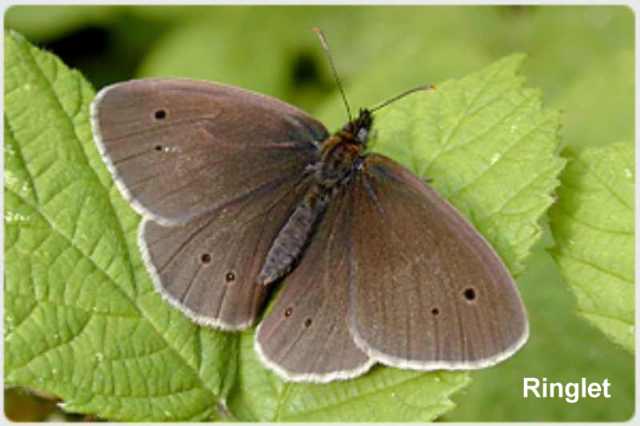 Aphantopus hyperantus
Aphantopus hyperantus
Distribution: This widespread butterfly has extended it range in England and Scotland in recent years.
Habitat: Tall grassland is used, mainly in damp situations in partial shade on heavy soils where grasses are lush, especially in woodland rides and
glades. The butterfly also occurs on commons, verges, and riverbanks, especially on clay soils. In northern areas, it is found in more open, less shady,
situations.
Diet: Coarser grasses are used, including Cock's-foot, False Brome, Tufted Hair-grass, Common Couch, and meadow-grasses.
|
|
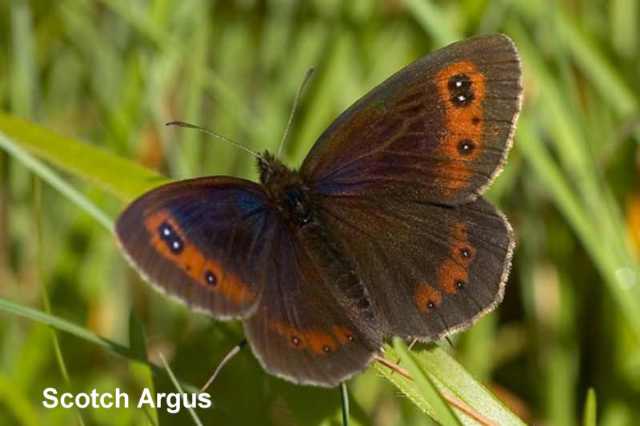 Erebia aethiops
Erebia aethiops
Distribution: Widespread in Scotland. Only found in two places in north-west England.
Habitat: The Scotch Argus occurs in damp, acid or neutral grassland up to 500 m in montane regions of Scotland, and around the fringes of sheltered
bogs, in woodland clearings, and young plantations. In northern England it is now restricted to two sites that contain a mosaic of sheltered limestone
grassland, scrub, and woodland. The butterfly is found only in tall grasslands that are lightly grazed or ungrazed.
Diet: The main foodplant in Scotland is thought to be Purple Moor-grass and the populations in northern England use Blue Moor-grass
|
|
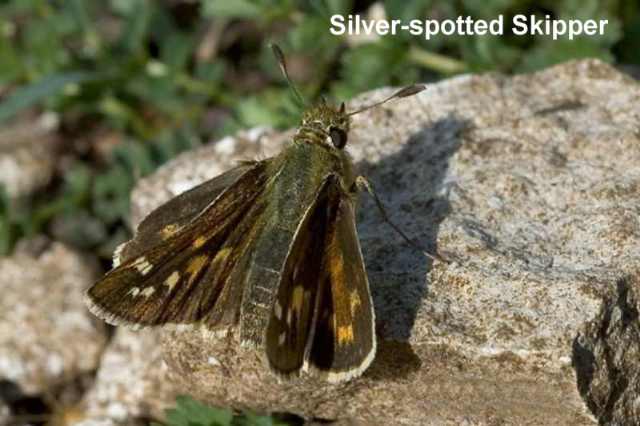 Hesperia comma
Hesperia comma
Distribution: This butterfly is restricted to chalk downland sites in southern England and is one of the few species that is increasing its range..
Habitat: This butterfly is found on chalk grassland that contains short, sparse, turf. This warmth-loving species is typically found on south facing slopes
on which its sole foodplant, Sheep's-fescue, grows.
Diet: The sole foodplant is Sheep's-fescue.
|
|
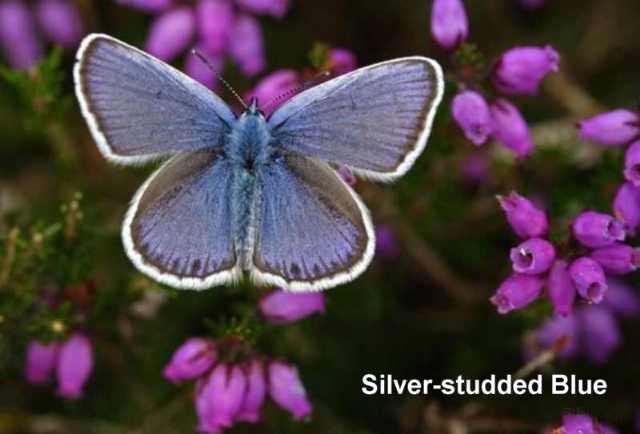 Plebeius argus
Plebeius argus
Distribution: These rare butterfly is confined to small colonies in England and Wales.
Habitat: Three main habitats are used: lowland heathland (the most widely used); calcareous grasslands (in north Wales, Pembrokeshire, and the
Isle of Portland in Dorset); and sand dunes (for example in Cornwall). It occasionally occurs in other habitats such as bogs.
Diet: A wide variety of ericaceous and leguminous plants are used: on heathland the most common are Heather, Bell Heather, Cross-leaved Heath,
gorses; and on calcareous sites mainly Common Bird's-foot-trefoil, Common Rock-rose, and Horseshoe Vetch.
|
|
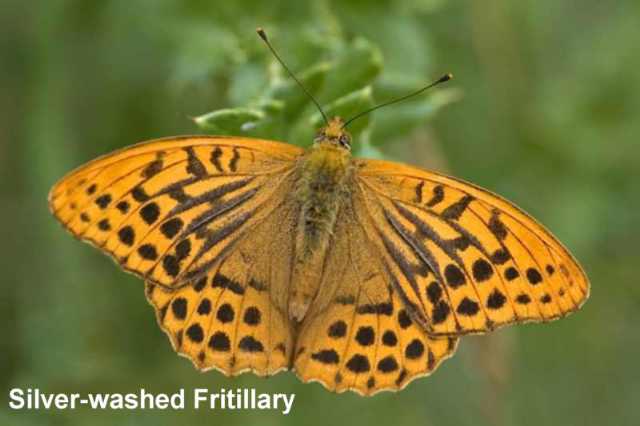 Argynnis paphia
Argynnis paphia
Distribution: Widespread across southern England and Wales and more locally in northern England and Ireland.
Habitat: The butterfly breeds in broad-leaved woodland, especially oak woodland or woods with sunny rides and glades. It occasionally uses mixed
broad-leaved and conifer plantations and, in parts of south-west England and Ireland, also breeds in wooded hedgerows and sheltered lanes near to woods.
Diet: The main foodplant is Common Dog-violet growing in shady or semi-shady positions on the woodland floor.
|
|
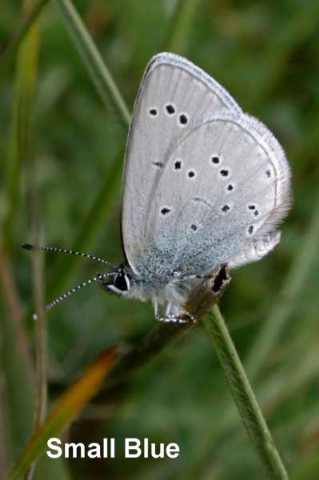 Cupido minimus
Cupido minimus
Distribution: The small blue is relatively widely distributed but rare in calcicolous and coastal habitats throughout England, Scotland, Wales and at a single
site in Northern Ireland. It has declined severely in many areas since 1950.
Habitat: Sheltered grasslands along the coastal areas of Britain, in man-made habitats such as quarries, gravel pits, road embankments and disused
railway lines.
Diet: Eats only the yellow flowers of the kidney vetch plant.
|
|
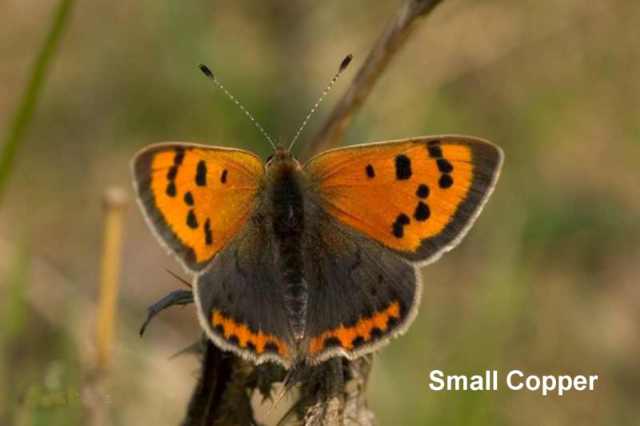 Lycaena phlaeas
Lycaena phlaeas
Distribution: Though it remains a common and widespread species throughout the U.K. the Small Copper declined throughout its range during the twentieth
century.
Habitat: It occurs in a wide variety of habitats: chalk grassland, moorland, heathland, coastal dunes and undercliffs, woodland clearings, and
unimproved grassland. This species may be found also in small patches of land such as set-aside fields, roadside verges, railway embankments, allotments,
churchyards, and waste ground, even in cities. Warm, dry situations are especially favoured.
Diet: Common Sorrel and Sheep's Sorrel are the main foodplants. Broad-leaved Dock may occasionally be used. .
|
|
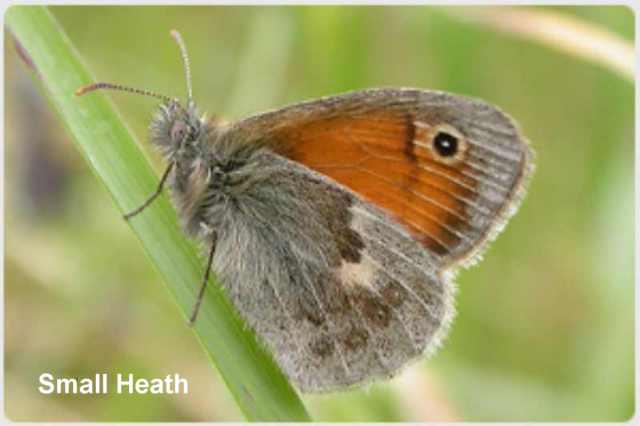 Coenonympha pamphilus
Coenonympha pamphilus
Distribution: This butterfly has a large range and is found throughout most of the UK.
Habitat: This species occurs on grassland where there are fine grasses, especially in dry, well-drained situations where the sward is short and sparse.
The largest colonies occur on downland, heathland, and coastal dunes.
Diet: Fine grasses, especially fescues, meadow-grasses, and bents.
|
|
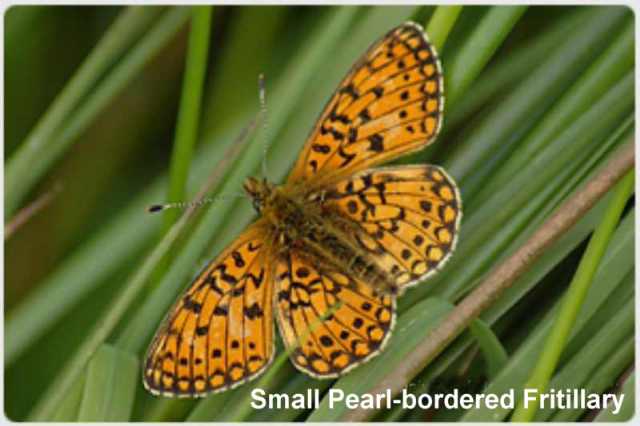 Boloria selene
Boloria selene
Distribution: The butterfly remains widespread and locally abundant in Scotland and Wales, but has undergone a severe decline in England.
Habitat: Occurs in damp, grassy habitats as well as woodland clearings and moorland.
Diet: The most widely used foodplants are Common Dog-violet and Marsh Violet. It may occasionally feed on other violet species.
|
|
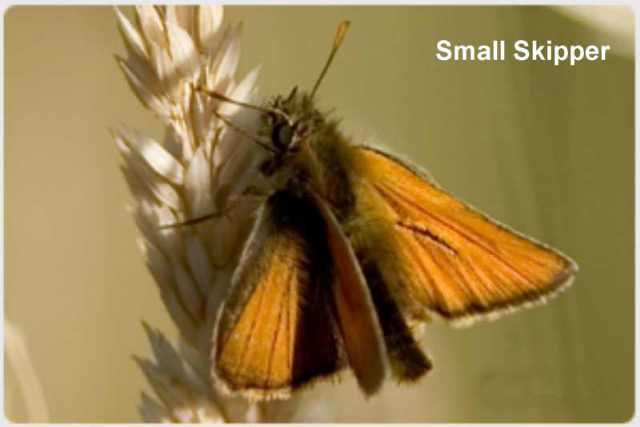 Thymelicus sylvestris
Thymelicus sylvestris
Distribution: The butterfly is widespread in southern Britain and its range has expanded northwards in recent years.
Habitat: Small Skipper colonies are found where grasses are allowed to grow tall. Typical habitats are unimproved rough grassland, downs, verges,
sunny rides, and woodland clearings.
Diet: The Small Skipper almost exclusively uses Yorkshire-fog, although several other grasses have been recorded as foodplants, for example Timothy,
Creeping Soft-grass, False Brome, Meadow Foxtail, and Cock's-foot.
|
|
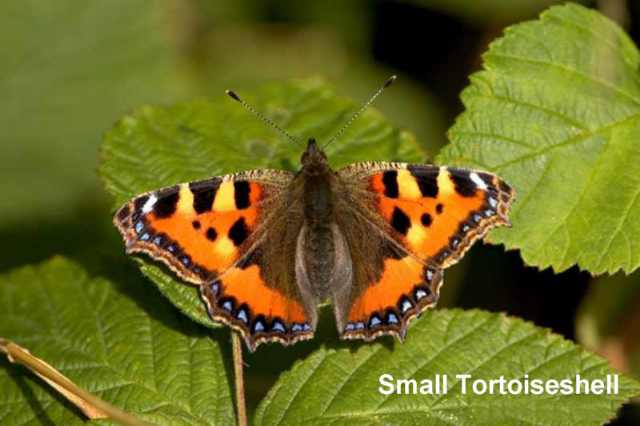 Aglais urticae
Aglais urticae
Distribution: The butterfly is widespread throughout the UK.
Habitat: Meadows, gardens, and waste ground with wild flowers.
Diet: Caterpillars feed on nettles, spinning leaves together. Adults drink nectar from flowers such as thistles and buddleia.
|
|
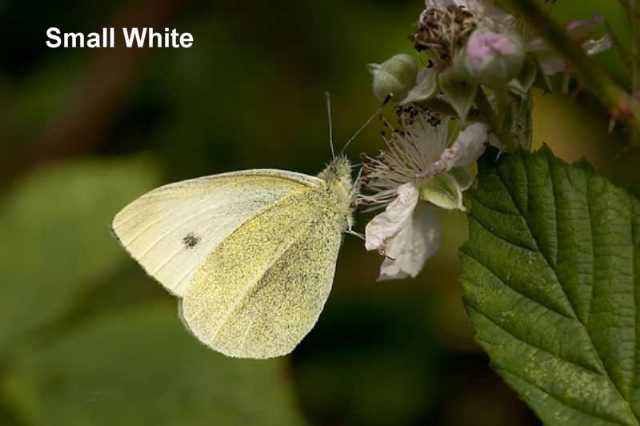 Pieris rapae
Pieris rapae
Distribution: A small strong-flying butterfly, common and widespread throughout Britain and Ireland.
Habitat: This species is found in a wide variety of habitats and can turn up almost anywhere, including gardens, allotments, parks, meadows, open
grassland, and hedgerows.
Diet: The main foodplants are Cruciferae family and Nasturtium. Charlock, Garlic Mustard, Hedge Mustard, Hoary Cress, Wild Cabbage and Wild
Mignonette are also used.
|
|
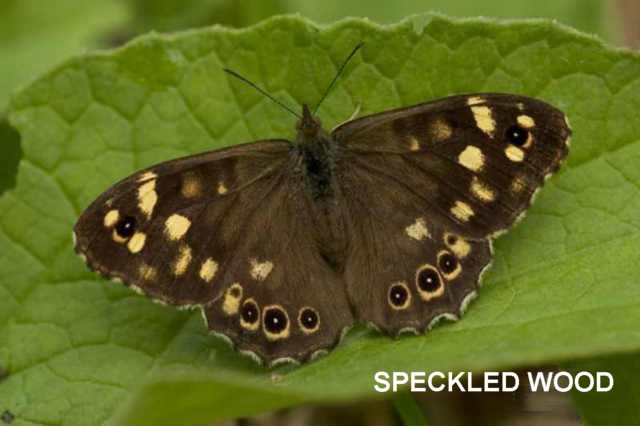 Pararge aegeria
Pararge aegeria
Distribution:The range of this butterfly contracted during the late nineteenth and early twentieth centuries, but has spread back since the 1920s.
It has continued to spread over the past two decades, recolonizing many areas in eastern and northern England and Scotland.
Habitat:Towards the northern and eastern margins of its range, the Speckled Wood breeds only in woodland habitats, but elsewhere it also
uses lanes and tracks between tall hedgerows, parks, gardens, and scrub. It seems to prefer slightly damp areas where there is tall grass and some shade.
Diet:Various grasses are used, including False Brome, Cock's-foot, Yorkshire-fog, and Common Couch.
|
|
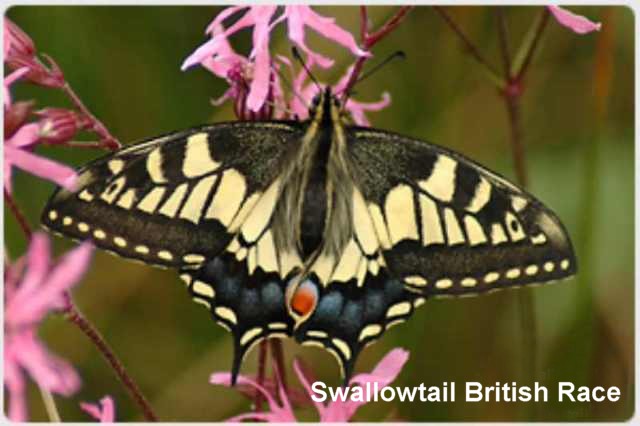 Papilio machaon
Papilio machaon
Distribution:A large, strong-flying butterfly restricted to the Norfolk Broads, although migrants are occasionally seen elsewhere.
Habitat:The British race britannicus breeds only in open fens and marshes that support vigorous growths of Milk-parsley. The butterfly prefers
areas of mixed fen usually dominated by sedge, or sometimes reed, which are cut periodically and contain tall, prominent foodplants
Diet:The native British race feeds solely on Milk-parsley. Occasional migrants of the continental race gorganus use a variety of umbellifers
such as Wild Carrot and Wild Angelica.
|
|
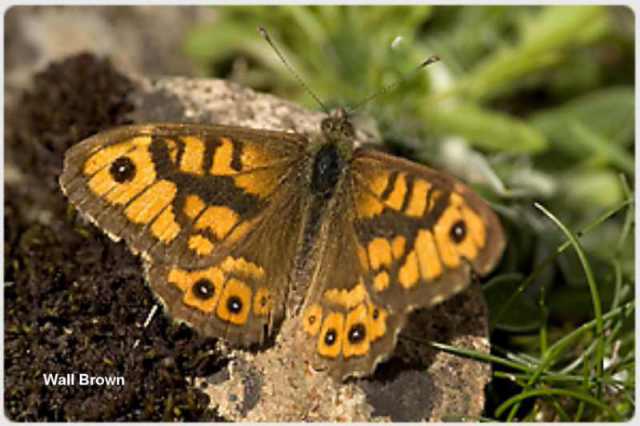 Lasiommata megera
Lasiommata megera
Distribution:Apart from the far north of England, high parts of the Pennines and Scotland where distribution is rare, the Wall Brown is a common
butterfly throughout much of the British Isles. The butterfly has however declined since the mid 1980s and vanished from many of its former haunts.
Habitat:The Wall breeds in short, open grassland where the turf is broken or stony. It is found in dunes and other coastal habitats (including
vegetated undercliffs and rocky foreshores) as well as disturbed land (including railway embankments and cuttings), disused quarries, derelict land, and
gardens.
Diet:Various grasses are used, including Tor-grass, False Brome, Cock's-foot, bents, Wavy Hair-grass, and Yorkshire-fog.
|
|
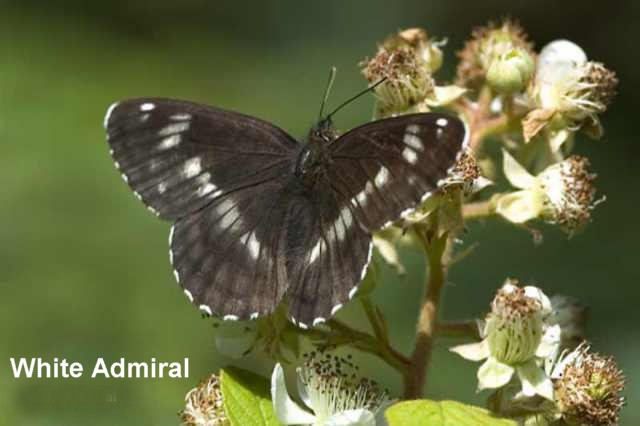 Limenitis camilla
Limenitis camilla
Distribution:The White Admiral occurs widely in southern Britain and has spread rapidly since the 1920s, after an earlier contraction. However,
population monitoring has shown a dramatic decline in the last 20 years for reasons that are as yet unclear.
Habitat:The butterfly uses shady woodland and ride edges, often associated with neglected or mature woodland where there are sunny glades
with large patches of Bramble to provide nectar for the adults. It is found in both deciduous and mixed deciduous/coniferous woodland.
Diet:The sole foodplant is Honeysuckle, usually in shady positions.
|
|
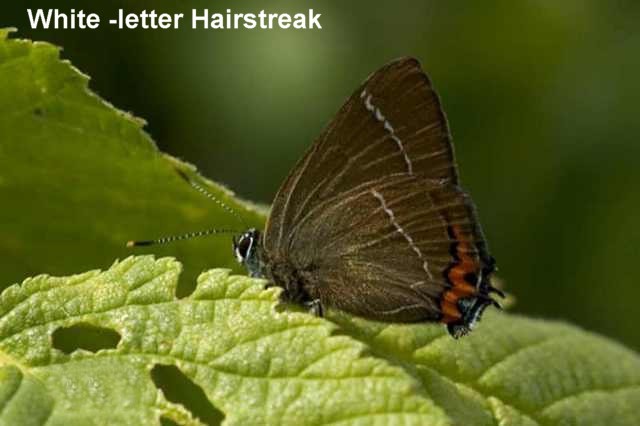 Satyrium w-album
Satyrium w-album
Distribution:A small butterfly which lives in the tops of elm trees throughout England and Wales, but is often overlooked.
Habitat:It breeds where elms occur in sheltered hedgerows, mixed scrub, and the edges of woodland rides, and also on large, isolated elms.
It was previously thought to have a strong preference for large, mature elm trees, but is now found frequently on younger elm growth.
Diet:The butterfly breeds on various elm species, including Wych Elm, English Elm, and Small-leaved Elm.
|
|
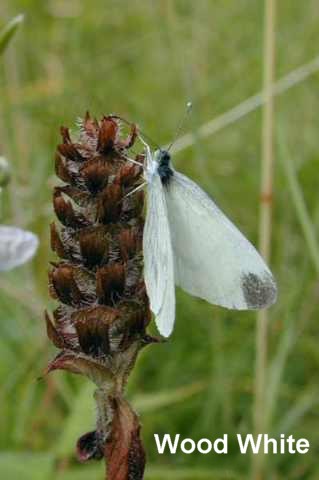 Leptidea sinapis
Leptidea sinapis
Distribution:The butterfly has declined seriously in England and Wales. In Ireland it has so far been found only in the Burren, whilst its sister
species, Real's Wood White, is widespread and has expanded northwards in recent decades.
Habitat:The Wood White breeds in tall grassland or light scrub in partially shaded or edge habitats. In Britain, most colonies breed in
woodland rides and clearings, though a few large colonies occur on coastal undercliffs.
Diet:Various legumes are used, commonly Meadow Vetchling, Bitter-vetch, Tufted Vetch, Common Bird's-foot-trefoil, and Greater
Bird's-foot-trefoil.
| |

